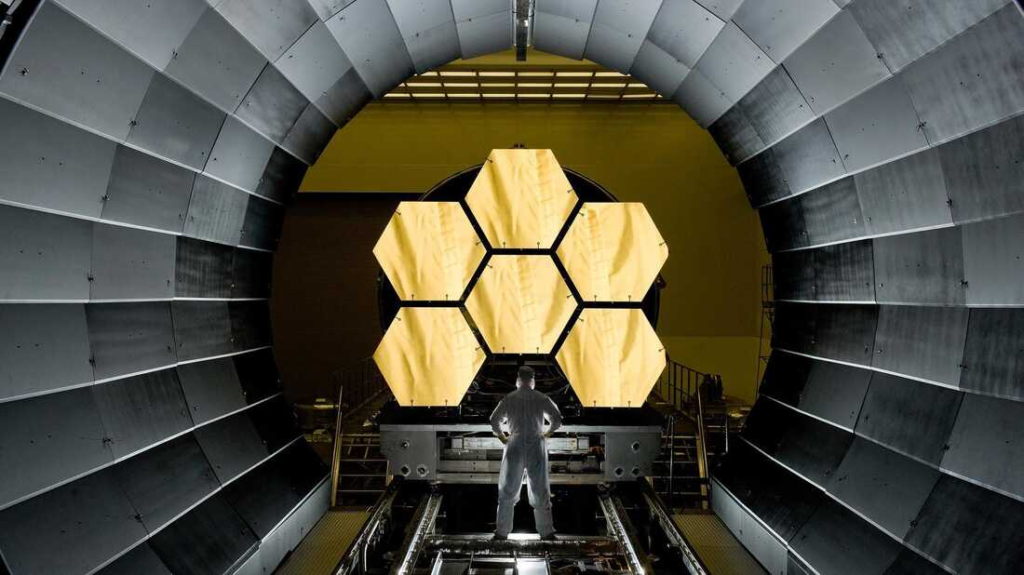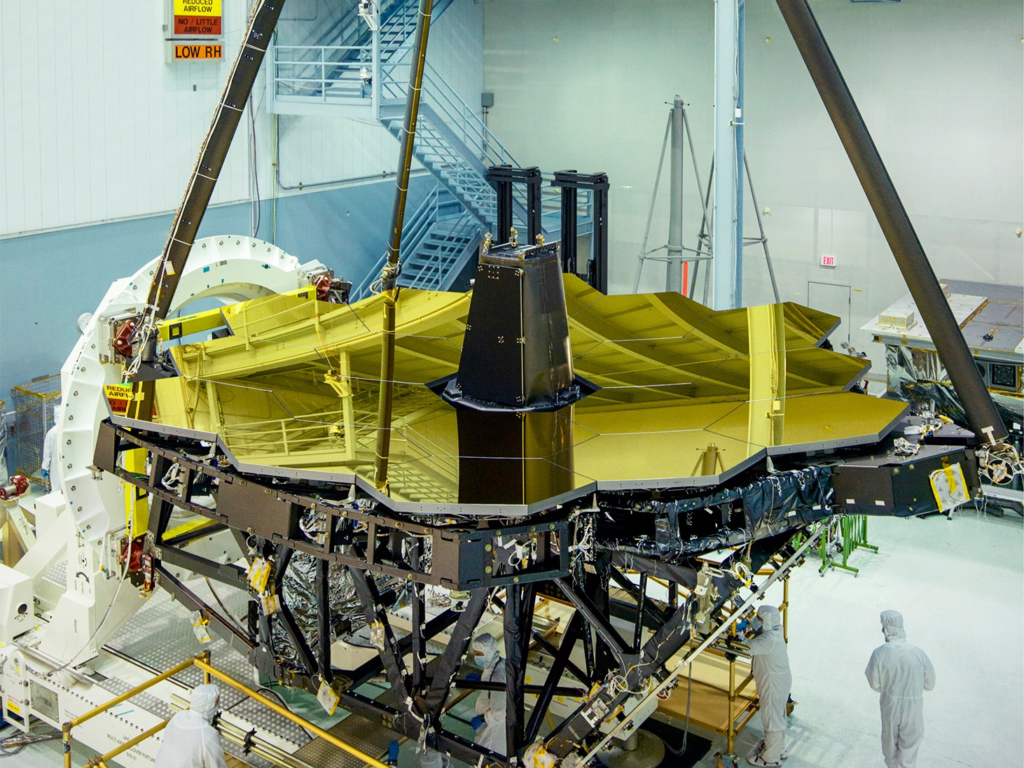
How The James Webb Space Telescope Endures Impacts
After around half a year since the launch, the James Webb Space Telescope continues to make progress and work towards being fully operational. Recently, NASA has updated us on a lot of exciting information regarding Webb such as a date for the release of the telescope’s first full-color images and more. This being said, while a lot of Webb’s progress has gone smoothly, space is a very harsh environment that presents many different challenges.
One of these challenges is the constant debris and objects flying through the universe at hard to imagine speeds. Yesterday, NASA gave us more information on the telescope and specifically a micrometeoroid impact on one of the primary mirror segments. However, the agency points out that while not ideal, the telescope was made for things like this.
In addition to the update, NASA provided a lot of information on how exactly the James Webb Space Telescope was built to withstand impacts like these and the impact it will have on the telescope’s lifecycle. Here I will go more in-depth into the recent news on the impact, and what makes Webb so special and durable in space.
Webb’s Recent Impact

Just yesterday, NASA gave us some information on a specific micrometeoroid strike on Webb’s primary mirror. Specifically, they first tweeted saying, “Micrometeroid strikes are an unavoidable aspect of operating any spacecraft, and we expect that impacts will continue to occur throughout Webb’s lifetime. Our team built and tested the mirror on the ground anticipating such events.” They followed up by providing an example in another tweet mentioning, “In late May, Webb sustained a dust-sized micrometeoroid impact to a primary mirror segment. Not to worry: Webb is still performing at a level that exceeds all mission requirements.” They went on to highlight that micrometeoroid strikes are an unavoidable aspect of operating any spacecraft, which routinely sustain many impacts over the course of long and productive science missions in space. Between May 23 and 25, NASA’s James Webb Space Telescope sustained an impact to one of its primary mirror segments. After initial assessments, the team found the telescope is still performing at a level that exceeds all mission requirements despite a marginally detectable effect in the data. Thorough analysis and measurements are ongoing. Impacts will continue to occur throughout the entirety of Webb’s lifetime in space; such events were anticipated when building and testing the mirror on the ground. After a successful launch, deployment, and telescope alignment, Webb’s beginning-of-life performance is still well above expectations, and the observatory is fully capable of performing the science it was designed to achieve.
The impact is not ideal, however, Webb’s mirror was engineered to withstand bombardment from the micrometeoroid environment at its orbit around Sun-Earth L2 of dust-sized particles flying at extreme velocities. While the telescope was being built, engineers used a mixture of simulations and actual test impacts on mirror samples to get a clearer idea of how to fortify the observatory for operation in orbit. This most recent impact was larger than was modeled, and beyond what the team could have tested on the ground. Although space is mostly empty, there is some debris. In the inner Solar System where Webb will orbit, NASA has a good understanding of what the population of meteoroids is like from years of observations and research. It’s mostly dust and very small particles, with the majority being sparsely distributed and tinier than grains of sand. There are some pebbles, rocks, and boulders, but they are very sparse and very rare. At Webb’s orbit at L2, the debris is all natural and the environment is not as hazardous as it is much closer to Earth, where there is a fair amount of human-generated space junk. In addition, almost all of Webb’s sensitive components (besides the mirrors and sunshield) are protected behind “micrometeoroid armor.” When micrometeoroids do strike, most are so small that they totally disintegrate upon impact, even when they hit something thin like thermal blankets or a sunshield membrane. Critical wires and electronics are shielded behind even more robust metal “armor” or inside metal boxes.
In terms of the recent impact, “We always knew that Webb would have to weather the space environment, which includes harsh ultraviolet light and charged particles from the Sun, cosmic rays from exotic sources in the galaxy, and occasional strikes by micrometeoroids within our solar system,” said Paul Geithner, technical deputy project manager at NASA’s Goddard Space Flight Center in Greenbelt, Maryland. “We designed and built Webb with performance margin – optical, thermal, electrical, mechanical – to ensure it can perform its ambitious science mission even after many years in space.” For example, due to careful work by the launch site teams, Webb’s optics were kept cleaner than required while on the ground; their pristine cleanliness improves the overall reflectivity and throughput, thereby improving total sensitivity. This and other performance margins make Webb’s science capabilities robust to potential degradations over time.
Furthermore, Webb’s capability to sense and adjust mirror positions enables partial correction for the result of impacts. By adjusting the position of the affected segment, engineers can cancel out a portion of the distortion. This minimizes the effect of any impact, although not all of the degradation can be canceled out this way. Engineers have already performed a first such adjustment for the recently affected segment C3, and additional planned mirror adjustments will continue to fine tune this correction. These steps will be repeated when needed in response to future events as part of the monitoring and maintenance of the telescope throughout the mission. If you were looking right at the front of the James Webb Space Telescope, the affected mirror would be at the bottom right of the telescope.
In order to protect Webb in orbit, flight teams can use protective maneuvers that intentionally turn the optics away from known meteor showers before they are set to occur. This most recent hit was not a result of a meteor shower and is currently considered an unavoidable chance event. As a result of this impact, a specialized team of engineers has been formed to look at ways to mitigate the effects of further micrometeoroid hits of this scale. Over time, the team will collect data and work with micrometeoroid prediction experts at NASA’s Marshall Space Flight Center to be able to better predict how performance may change, bearing in mind that the telescope’s initial performance is better than expected. Webb’s tremendous size and sensitivity make it a highly sensitive detector of micrometeorites; over time Webb will help improve knowledge of the solar system dust particle environment at L2, for this and future missions.
“With Webb’s mirrors exposed to space, we expected that occasional micrometeoroid impacts would gracefully degrade telescope performance over time,” said Lee Feinberg, Webb optical telescope element manager at NASA Goddard. “Since launch, we have had four smaller measurable micrometeoroid strikes that were consistent with expectations and this one more recently that is larger than our degradation predictions assumed. We will use this flight data to update our analysis of performance over time and also develop operational approaches to assure we maximize the imaging performance of Webb to the best extent possible for many years to come.”
Additional Update

While the impact on Webb’s mirror is important to point out, in the meantime, the telescope has continued to make progress as it gets closer to being fully operational. Specifically, in the lead-up to the release of Webb’s first full-color images and spectroscopic data on July 12, the Webb team is now in the last phase of commissioning the science instruments. The first two instrument modes, NIRCam imaging, and NIRISS imaging, have been declared ready for science. After commissioning is finished, the discoveries will begin, implementing the hundreds of peer-reviewed science programs that have been selected for Webb’s first year. The area on the sky that Webb can see at any given time is called the field of regard. Deciding which observations to make on which day is a complicated process designed to optimize observational efficiency and manage the observatory’s resources. “Webb’s first year of observations (Cycle 1) has already been selected. There are three types of scientific programs planned: General Observer (GO), Guaranteed Time Observer (GTO), and Director’s Discretionary Early Release Science (DD-ERS). The GO and DD-ERS programs include scientists from all over the world whose programs were selected in a dual anonymous peer review process. The GTO programs are led by scientists who made key contributions to the development of the observatory.”
Conclusion
The James Webb Space Telescope has shown very promising results throughout the last few months. As of right now, teams at NASA are getting very close to performing consistent science observations with the telescope. Recently it was struck by a micrometeoroid but is fine thanks to the fascinating engineering and design. We will have to wait and see how it progresses and the impact it has on the space industry.
